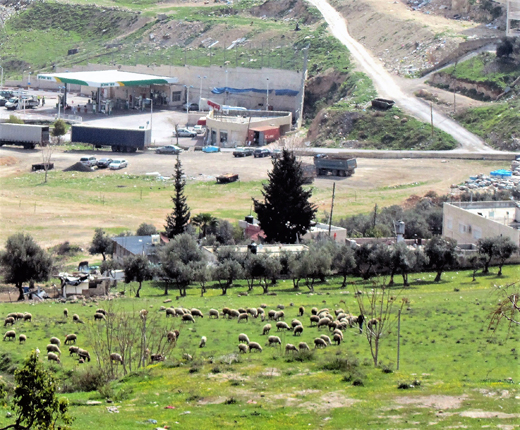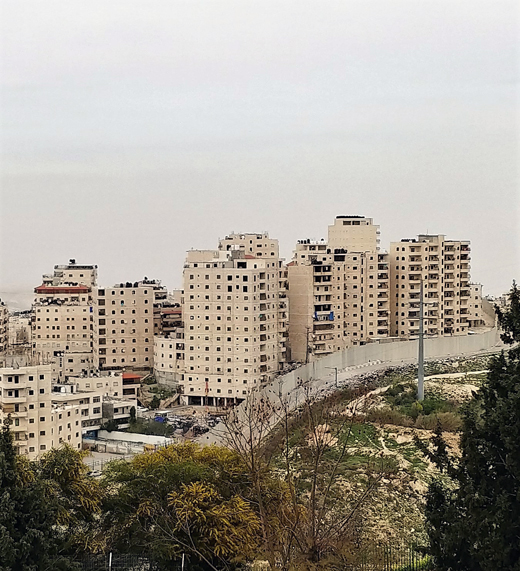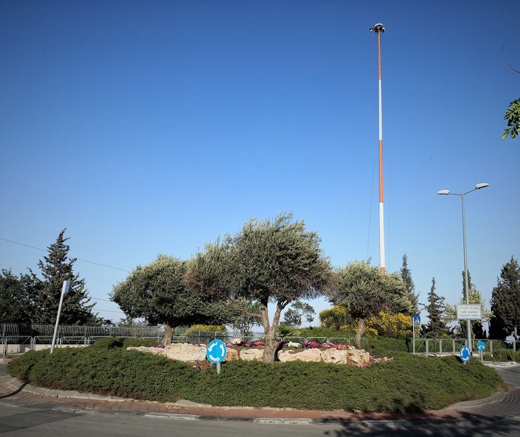
By Ira Sharkansky

JERUSALEM — For more than 26 years I’ve been thinking about what’s near and far while looking east from our balcony.
At first, we could see a bit of the Dead Sea, but the builders of Isaweea have gone skyward and cut off our view.
Isaweea is the congestion off to the right. We see less than half of it, and all told it has about 15,000 residents. Arab friends tell us that most are Bedouin, and that keeps other Arabs from marrying with them.
The field between us and them often has flocks of sheep and goats enjoying the grass.

Most of Isaweea was in the Mt Scopus enclave that remained under Israeli control between 1948 and 1967, so it may claim to be more Israeli than our neighborhood of French Hill, which came into Israel in 1967.
Isaweea is a hostile place. I’ve been advised to stay away. Jews who have wandered into the village have been attacked by some residents and saved by others. A post office established there was trashed. Fire trucks will enter only with Arab personnel.and a police escort.
There’s no wall between us and them, but usually a police presence at the exit from Isaweea to French HIll and at the nearby gas station where Isaweeans work and serve both neighborhoods. It has been attacked–so far unsuccessfully–with home made firebombs..
Occasionally we go to sleep to the sound of gun fire and stun grenades, which we’ve learned to distinguish from the fireworks that mark weddings and school graduations. At one time our neighbors fired guns in celebration, using live ammunition rather than blanks. What went up came down, sometime to the misfortune of celebrants.

To the left of our view and beyond the trees that are part of French Hill, are the recently built high rises of Shuafat and Anata. The latter may be on the site of the Biblical Anathoth, known as the home of the Prophet Jeremiah. The western part of Shuafat is an upscale Arab neighborhood, and its eastern part is poor and forsaken, known as a refugee camp, which was its status from 1948 to 1967. Shuafat but not Anata are within Jerusalem. The view from our balcony shows the wall which begins at the entrance to the Shuafat refugee camp and and extends between us and Anata. There’s a major crossing point through the wall which usually lets residents reach other parts of Jerusalem, but has also been the scene of what’s more exciting.
A bit to the north, and along our daily walks, some of our French Hill neighbors’ homes seem right alongside the newly built high rises of Shuafat. Between them, however, is a deep valley that makes the operational distance much greater. Looking closely at the buildings, it appears that many of the flats are not yet occupied. Reports are that money from Qatar enabled some quick building, motivated to put an Arab stamp on the land in order to keep it from the Jews.
Explanations of the wall provided by leftists and anti-Semites describe Israeli imposed Apartheid. To the rest of us, it is something produced by the Intifada of 2000-05, that has kept us safer. The part of Shuafat that used to be a refugee camp is open on the east to migrants from the West Bank, and has become home to perhaps 80,000 people, many of whom lack legitimate status in Israel.

Further along our walks, there’s a traffic circle with olive trees, flowers, and other greenery. Alongside is a tower that sends pictures of what’s happening on the other side of the wall to a nearby military base. Crews of soldiers, most likely women, monitor those pictures, and report up the chain when appropriate.
We’ve seen violence on our neighborhood walks, as well as familiar Arab faces with whom we share greetings. Jews and Arabs play football (soccer) in the school yard that abuts our home, only occasionally in mixed groups. We’ve met some of both in a congenial manner when a ball has flown onto our balcony. We’ve also had a fist-sized stone thrown into our window, and someone painted “Fuck the Jews” on the school wall.
Many East Jerusalem Arabs work in the building trades, and they build their own homes. There’s a lack of planning and greenery, with some homes edging out onto what used to be roadways. There’s also a lack of pavement on some of the roads that we see, and we hear of rubbish piles.
Are the problems a reflection of Jewish meanness or Arab rejection of Israeli authority and the opportunity to vote in local elections?
Jerusalem is on a geographic fault with a history of severe earthquakes. The structures that we see outside of French Hill are not built according to standard, so we’ll hope to be somewhere else on the occasion of the next major quake when Arabs’ high rises are likely to become rubbish piles and the graves of their inhabitants.
We see three minarets from the right to the left sides of our eastern view, and hear their calls to prayer five times a day. The first is about 04:30 this time of the year. There are five synagogues within our neighborhood, and we hear a siren indicating the onset of the Sabbath on Friday afternoon.
Competing Knesset Members have tried passing legislation to control the noise from the mosques and to quiet the Sabbath siren.
We’re on the eastern edge of Jerusalem, and get almost as much rain in an average year (550 mm) as London. However, all of our’s comes between November and April. Then we see green in the nearby field, and eastward in diminishing strength. Beyond Isaweea and Anata are the browns and white of the Judaean Desert, where the average annual rainfall is 1 mm. On a clear day we see the line of the Jordan River in the Valley about 10 miles away, and buildings of Amman 35 miles away on the next hilltop.
It’s a small and intense place, never in its long history the sole possession of any one people.
*
Sharkansky is professor emeritus of political science at Hebrew University. He may be contacted via ira.sharkansky@sdjewishworld.com